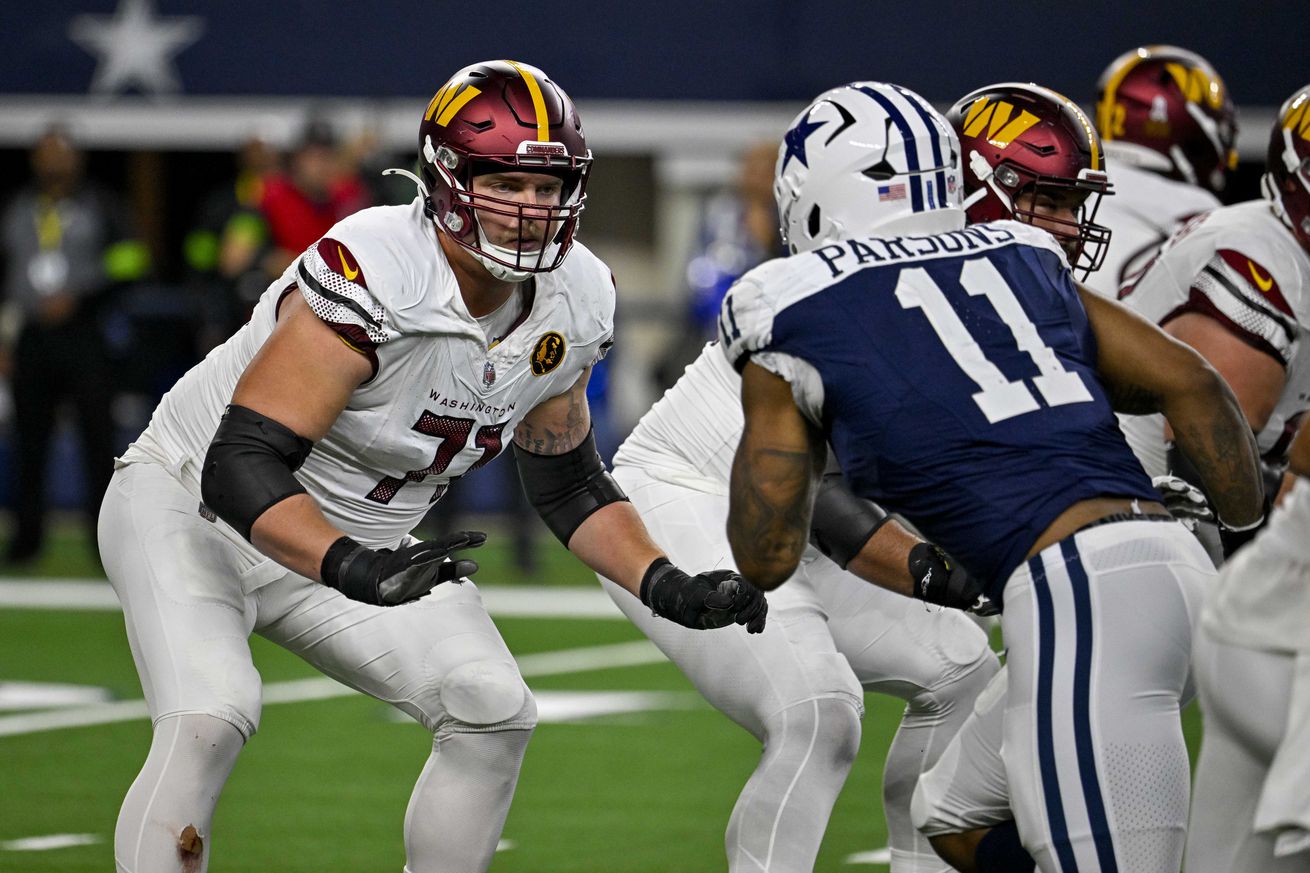
What were the real issues in 2023 and how much has been done to fix them?
This article was written in response to a request from Bill In Bangkok to republish a few pieces I wrote in the post-draft period, when HH readership was dipping into the summer lull. A few things have changed since then, so I decided instead to provide a recap as well as some updates.
Links to the original articles, for interested readers, are here:
Where Did the Pressure Come From? 2023 Commanders’ Offensive Line QB Pressure Stats
This article examined pressures allowed by Washington’s offensive line, broken down by position and player, as well as other factors contributing to Sam Howell’s struggle with the pass rush.
What is the reality of drafting rookie OTs who are better than Andrew Wylie and Cornelius Lucas?
This article examined results of the previous five NFL drafts to estimate the probability of drafting an offensive tackle capable of upgrading Washington’s pass protection in his rookie season.
These articles introduced a new metric, Pressure Rate, to quantify performance in pass protection. Pressure Rate is calculated as pressures allowed in pass protection per pass blocking snap. I expressed it as a percentage of pass block snaps. Pressure Rate is a direct measure of pass blocking productivity. By directly quantifying how well a blocker does at keeping defenders away from the QB, it is an improvement over indirect metrics, like pass block win rates, or subjective blocking grades.
The results of these quantitative analyses debunk some misconceptions that have been spread about the state of the Commanders’ offensive line in 2023, and also suggest that the biggest remaining weakness might not be what a lot of people seem to think.
To shed light on some frequently discussed topics this pre-season, here is a recap of the findings from my previous articles, along with some further analysis.
Myth: Washington had the worst pass-blocking OL in the NFL last season
Reality: The Commanders’ O-Line allowed just the 13th most pressure on passing downs. The Super Bowl teams were far worse.
I’ll kick things off with some new analysis. The following table ranks NFL offensive lines by Pressure Rate allowed on passing downs in 2023. This is simply the percentage of drop backs with pressure attributed to an offensive lineman.
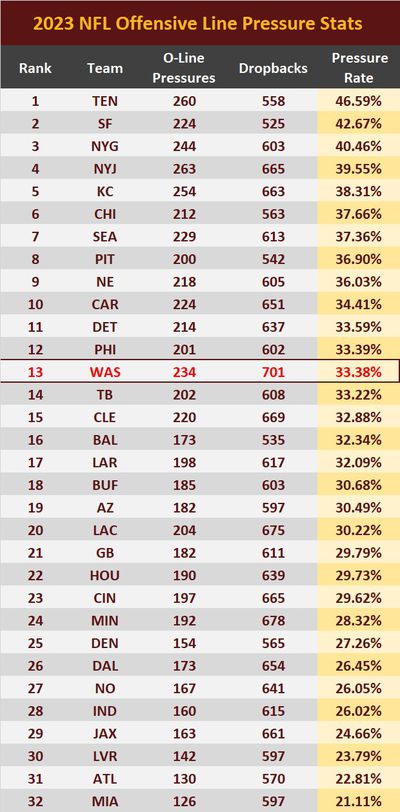
The Commanders’ much maligned OL allowed the fifth most total pressures (234) in the NFL last season, but ranked 13th in Pressure Rate allowed on passing downs. How could that be? It’s very simple. The Commanders ran more passing plays than any other team, leading the league in both Passing Attempts (636) and Dropbacks (701 Attempts + Sacks). The more a team passes the ball, the more opportunities it gives the defense to rush the passer, leading to more pressures allowed. A given offensive line will allow more pressures if the team passes the ball more, and fewer pressures if they run it more.
The offensive line of five playoff teams allowed higher Pressure Rates on passing downs than Washingtons’, including the two Super Bowl teams. The 49ers’ OL allowed the second highest Pressure Rate, and the Super Bowl Champion Chiefs allowed the fifth highest Pressure Rate.
Myth: The biggest issue in pass protection last season was the offensive line
Reality: QB play and offensive play calling were bigger problems
If the OL was just a little worse than league average in pass protection, why did Washington’s QBs take the second most sacks of any teams’? The question is really about Sam Howell, because Jacoby Brissett only took 3.2% of Washington’s dropbacks and didn’t take any sacks.
A big clue comes from the two Super Bowl teams. Despite their offensive lines giving up the 2nd and 5th highest rates of pressure on passing downs, the 49ers and Chiefs only ranked 27th and 31st in sacks taken by their quarterbacks (SF 34 sacks, KC 28 sacks). The reason for that apparent discrepancy was that the Super Bowl QBs were among the best in the league at avoiding pressure. The 49er’s Brock Purdy had a Pressure to Sack Rate of 14.1%, which ranked 28th among the 32 QBs with 284 or more dropbacks in the regular season. Patrick Mahomes was the second best QB at avoiding pressure, with an 11.2% Pressure to Sack Rate. Only Josh Allen was better at 10.3%.
Washington’s Sam Howell, on the other hand, was the third worst full time starting QB at avoiding pressure. His 22.8% Pressure to Sack Rate trailed only Bryce Young (24.5%) and Zach Wilson (24.3%). Howell converted pressure to sacks at over twice the rate of Josh Allen.
The second major issue contributing to Howell’s high sack count was play selection. As I mentioned above, Washington passed the most of any team in the NFL, thereby maximizing defenders’ opportunities to sack the QB. Unlike the other two factors, play selection was entirely under the team’s control.
The relative contributions of different factor to Sam Howell’s sack count in 2023 can be estimated with a simple value over replacement analysis. This involves keeping everything else constant and substituting one factor with a league average replacement. Total sack count is the mathematical product of pass blocking (Pressure Rate, expressed as proportion), QB pressure avoidance (Pressure to Sack Rate, expressed as proportion) and number of passing plays:
Total Sacks = Pressure Rate x Pressure to Sack Rate x Number of Passing Plays
To estimate the relative contribution of each individual factor, we can swap it out for the league average value and see what effect that has on total sack count.
OL Contribution: According to Pro Football Focus, Washington’s QBs experienced a total of 285 pressures, of which 234 were attributed to pass blocking losses by the OL, and 18 to other blockers. A total of 33 pressures were unattributed to blockers. I’m not sure if that means they were QB-generated or not, so I have left them out of the analysis.
Suppose the Commanders exchanged offensive lines with the LA Rams, who ranked 17th in Pressure Rate. Dropping the Pressure Rate allowed by the OL from 33.38% (0.334) to 32.09% (0.321) results in a reduction of pressures attributed to the OL from 234 to 225. Keeping Sam Howell’s Pressure to Sack Rate constant, this results in a reduction in sacks attributed to the OL from 53 to 52 (Jacoby Brissett only took 3.2% of Washington’s dropbacks, so it is safe to approximate by just using Howell’s stats).
Conclusion: The deficiency of Washington’s OL in pass protection, relative to league average, accounted for 1 additional sack.
QB Contribution: Now, suppose instead, the Commanders had upgraded from Sam Howell to the middle ranked QB in pressure avoidance. Baker Mayfield ranked 16th, with a P2S% of 18.3% and Lamar Jackson 17th with a P2S% of 18.2%. Let’s split the difference and say the median P2S% was 18.25%. Switching from Howell’s Pressure to Sack Rate to the league average drops the total sack count from 65 (28 x 0.228) to 52 (285 x 0.1825).
Conclusion: Sam Howell’s deficiency in avoiding pressure, relative to league average, accounted for 13 additional sacks. Note that, if unattributed pressures are the fault of the QB, this is likely an underestimate.
Play Caller Contribution: Lastly, suppose that Washington had kept all of its players the same and simply ran a more balanced offense. Reducing the number of passing plays from a league high 701 to the league median 612 reduces the number of sacks taken from 65 to 57.
Conclusion: The imbalance in Washington’s play selection, relative to league average, accounted for 8 additional sacks. Note that this does not even take into account the fact that running the ball more makes it harder for defenses to key on the QB. That makes it a conservative estimate.
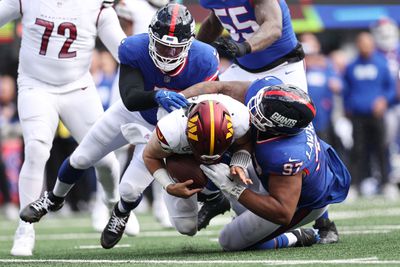
Photo by Dustin Satloff/Getty Images
Myth: Andrew Wylie is the worst starting RT in the NFL
Reality: Wylie was a little below average in pass protection last season
Andrew Wylie allowed the 13th most pressures (42, tie with Charles Cross and Donovan Smith) and the 4th most sacks (9, tie with Jaelyn Duncan, Colton McKivitz, Trey Pipkins III) among OTs in 2023. He also played the 11th most pass block snaps. To make sense of those raw stats, we have to adjust by playing time. As we just saw, sacks taken have more to do with the QB than pass blocking, so Pressure Rate is a better indicator of blocking performance than Sack Rate.
Wylie allowed a Pressure Rate of 6.06% in pass protection last season. That ranked 20th among NFL starting right tackles. Twelve teams started right tackles who were worse in pass protection than Wylie.
Wylie has shown steady improvement in pass protection since converting to RT full time in 2021 with the Chiefs. His Pressure Rate stats are trending in the right direction:
2021 8.84%
2022 6.59%
2023 6.06%
Myth: Cornelius Lucas is below starting level at LT
Reality: Around half of the league’s starting LTs were worse in pass protection in 2023
Lucas has been in the NFL since 2014, when he signed with Detroit as an UDFA out of Kansas State. He has spent most of his career as a swing tackle, mostly playing RT when called into action. He has started seven or more games in three of his four seasons with Washington, due to the instability of the team’s offensive line.
Lucas had his best pro season in 2020, when he started 8 games for the Commanders at LT and allowed a miserly 3.97% Pressure Rate, and was only credited with 2 sacks. His 2020 Pressure Rate would have ranked 7th among starting LTs last season. Lucas had rough seasons in 2021 and 2022, starting 7 and 12 games at RT and allowing Pressure Rates of 7.06% and 9.55% respectively.
In 2023, Lucas started four games at LT, allowing a Pressure Rate of 5.26%. Had he maintained that Pressure Rate through a full season, he would have ranked 16th among starting LTs. His performance in pass protection was right on league average.
To this point in the pre-season, it appears that Lucas has lost the starting job to third round pick, Brandon Coleman. That is obviously a promising development for the team’s future. It could also be a relief to Commanders fans, because we don’t have to worry whether we get the 2022 Cornelius Lucas or the 2023 version. If he is required to start, and plays like last season, the Commanders could have done a lot worse.
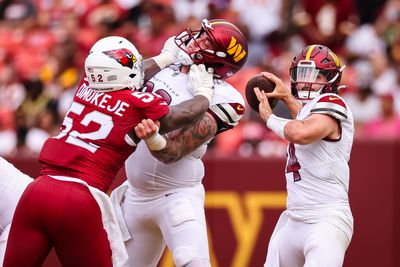
Photo by Scott Taetsch/Getty Images
Myth: Offensive tackle was the biggest problem on the OL in 2023
Reality: The interior offensive line was a much bigger issue in pass protection
The interior offensive line gave up 140 total pressures, compared to 94 pressures given up by the OTs. Therefore, the Commanders’ iOL was credited with 59.8% of OL pressures. Only six teams had a higher proportion of pressure from the iOL. League median was 51.5%.
That is unusual. Typically, the iOL gives up equal or fewer pressures than the OTs. While there are three iOL positions to two OTs, interior linemen tend to allow lower Pressure Rates in protection for two reasons. First, an interior lineman has to protect two gaps, with help on both sides; while an OT has to defend a gap and an edge, where he is usually on his own. Second, OTs tend to match up against opponents’ best pass rushers.
Consequently, the different OL positions tend to give up pressures at different rates. In 2023, the median Pressure Rate for starting centers was 3.87%, for starting guards 4.81% and for starting OTs 5.63%. The pattern on the Commanders’ OL was completely different. The centers gave up pressures at a rate of 5.77%, the guards at a rate of 6.09% and the OTs at a rate of 6.01%. While the Commanders OTs were only slightly below average in pass protection, the centers and guards were much worse than league average. The deficiency at guard was all on the left side, since RG Sam Cosmi was the only Commanders’ OL who was better than league average at his position.
Myth: Andrew Wylie was the worst pass blocker on the Commanders’ OL in 2023
Reality: Andrew Wylie played like a below average starting RT. The starting LGs were the worst in the NFL.
As I mentioned above, Wylie ranked 20th in Pressure Rate allowed among 32 starting RTs. His 6.06% Pressure Rate allowed in protection was just 0.04% below the class average of 6.02%. Grading on a bell curve, like I did in my recent article on WR catch rates, that rates a solid C.
The worst pass blocker among Washington’s starters last season was LG Saahdiq Charles. His 8.13% Pressure Rate was the highest among the 64 offensive guards with the most playing time. He was literally the worst starting guard in pass protection in the NFL. His pass blocking grade was an F. Chris Paul started 7 games at LG. He was slightly worse than Charles, allowing a pressure rate of 8.47%.
Myth: Anyone with a pulse would be better than Andrew Wylie
Reality: Finding an upgrade for this season on the current roster is a longshot
The panic about the RT position has got so extreme in certain circles, commenters have suggested replacing Wylie with players who are clearly much worse in pass protection. One name that was floated occasionally in offseason discussions was backup Trent Scott. Scott only saw the field for a total of 89 pass blocking snaps last season, but still managed to give up 10 pressures, for a Pressure Rate of 11.24%. He allowed pressures at nearly twice the rate as Wylie. Scott has been in the league since 2018. His best season at OT was 2020, when he started 4 games for Carolina and allowed a Pressure Rate of 6.57%, still higher than Wylie last season.
Aside from Trent Scott and swing tackle Cornelius Lucas, the Commanders don’t have any other OTs with significant NFL playing experience. With their starters out of action, the Commanders experimented with various backup and roster fringe players in the first preseason game against the Jets. 2023 UDFA Mason Brooks played a combination of LT and LG against NFL backups and gave up 5 pressures in 34 pass block snaps (14.7% Pressure Rate). Chris Paul held his own, splitting time between RG and RT (13/37 snaps), without allowing a single pressure in 25 pass block snaps. Second year OT Braeden Daniels only allowed a single pressure in 16 pass block snaps (6.25% Pressure Rate)
Some of the younger players might have developmental potential. But there is no obvious upgrade for Wylie for this season lurking in the depth ranks.
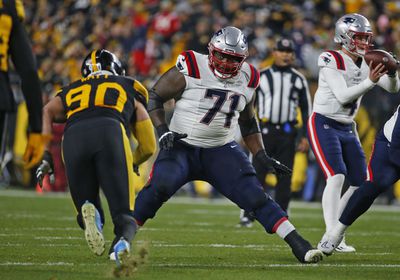
Photo by Justin K. Aller/Getty Images
Myth: The Commanders passed up plentiful options to upgrade the OT position
Reality: Only a few available FAs were better than Washington’s veteran starters and drafting an upgrade was a longshot
Several names of OTs the Commanders should have pursued in free agency have been thrown around. Among those who are healthy and not rehabbing major injuries, only four OTs on the FA market this offseason were better in pass protection than Wylie last season.
The only premium RT in his prime to hit the market was the Patriots’ RT Mike Onwenu (PR 4.55%). Onwenu said he wanted to stay in New England, and the Patriots clearly wanted to keep him. He re-signed with his team on a three year, $57 million contract, with $36.5 million guaranteed.
The next tier of FA OTs included Tyron Smith (PR 3.44%) and Jermaine Eluemunor (PR 5.07%). Smith is an All Pro LT, when healthy, but is 33 and has missed 37 games in the last four seasons. He signed a two year, $6.5 million contract with the Jets, who then drafted LT Olu Fashanu in the first round. Eluemunor signed a 2-year, $14 million contract with the Giants.
Bengals’ OT Jonah Williams (PR 5.62%) might have been a modest upgrade to Wylie. He signed a two year, $30 million contract with the Cardinals. Houston backup OT Josh Jones (PR 5.92%) had a slightly better Pressure Rate than Wylie with only three starts in 2023. He signed a 1-year, $1.79 million contract with the Ravens.
Several other names have been suggested of OTs who were clearly worse than Wylie in pass protection, or who are rehabbing major injuries. Worse options included Mekhi Becton (7.76% PR), Donovan Smith (7.70% PR) and Dan Moore Jr (9.66% PR). D.J. Humphries, La’el Collins and David Bakhtiari are rehabbing after major injuries or surgery. Bakhtiari has played 13 games in the last three seasons, and is recovering from surgery to finally correct a cartilage issue stemming from an injury in 2020. He turns 33 this season.
Having failed to shore up the OT position in free agency, the Commanders had another chance in the draft. With the second overall pick earmarked for QB Jayden Daniels, who was the highest rated player on the Commanders’ board, they would have been left looking for a first year starting OT with their highest remaining pick being the 36th overall in the second round. It has been rumoured that the Commanders attempted to trade back into the first round for an OT, but we don’t know what, if anything, was offered.
Trading up requires a trade partner, and the only way to force a deal is to overpay, as the previous regime in Washington was wont to do. All we know for sure is that Adam Peters didn’t overpay to pursue a trade.
There have been persistent complaints about the use of three second round picks on positions other than OT. Further angst has been expressed about the failure to double up on the position. The drafting OTs article, linked above, examined the probability of drafting OTs who are better than Andrew Wylie in pass protection in their rookie seasons. In the past five NFL drafts only 4 out of 12 (25%) of OTs drafted in the second round have been better than Andrew Wylie in pass protection in their rookie seasons. After the second round, the chance of drafting a first year starter who is better than Wylie right out of the gate is below 10%.
Instead of pursuing those long odds for an upgrade at OT in 2024, the Commanders used their second round picks on three players who show promise of developing into plus starters, early in their careers. They did invest a third round pick in OT Brandon Coleman, who is on track to win the starting LT position from veteran Cornelius Lucas. If Coleman not only starts, but also allows a Pressure Rate below 6.06% in pass protection this season, he will have beaten the odds. Only 1 of the 16 (6.3%) OTs selected in the third round of the last five drafts was better in pass protection in his rookie season than Andrew Wylie was last year.
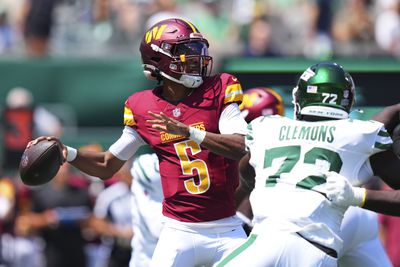
Photo by Mitchell Leff/Getty Images
Myth: Not enough was done to fix the Commanders’ pass protection this offseason
Reality: Resources were addressed to the biggest issues, in order of importance
A big reason why this nagging complaint persists is that it is open ended. Until the Commanders have the best pass protection in the league, then more needs to be done. In practical terms, however, offseason resources were directed to the biggest issues in pass protection, more or less in order of importance.
As we have seen, the biggest issue in pass protection was Sam Howell’s inability to avoid pressure. The Commanders used the second overall pick in the draft to upgrade the QB position.
The second biggest issue was play calling. Eric Bieniemy called the league’s highest proportion and total number of passing plays, resulting in maximal exposure of Howell’s weakness. Bieniemy was replaced this offseason by OC Kliff Kingsbury. Despite his association with pass-happy college Air Raid offenses, at the pro level, Kingsbury called a balanced offensive attack for much of his time with the Cardinals.
The third biggest issue was pass blocking. The OL was the biggest part of the problem, in terms of total pressures. The biggest problem on the OL was the interior, specifically center and LG. The Commanders signed Tyler Biadasz to a 3-year, $30 million contract to replace 2023 starting center Nick Gates.
If people need to complain about a weakness on the OL not being addressed, they should be focusing on left guard. The LG position allowed the most total pressures on the OL last season and was the weakest position relative to the rest of the league. The only additions at LG this season were low-cost free agent signings Nick Allegretti and Michael Deiter, who are both career backups.
Offensive tackle was the next weakest OL position in pass protection, after left guard and center. Nevertheless, the OT group was fortified by the addition of third round pick, Brandon Coleman. To this point in the preseason, despite injury setbacks, Coleman has exceeded expectations and is on track to win the starting LT job from veteran Cornelius Lucas.
